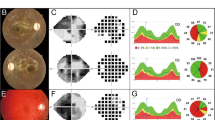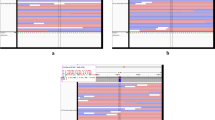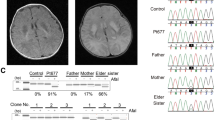Abstract
In order to explore the spectrum of mitochondrial DNA (mtDNA) mutations in Korean patients with Leber's hereditary optic neuropathy (LHON), we investigated the spectrum of mtDNA mutations in 145 Korean probands confirmed with the diagnosis of LHON. Total genomic DNA was isolated from the peripheral blood leukocytes of the patients with suspected LHON, and mtDNA mutations were identified by direct sequencing. Analysis of mtDNA mutations revealed seven primary LHON mutations including the nucleotide positions (nps) 11778A (101 probands, 69.2%), 14484C (31 probands, 21.2%), 3460A (5 probands, 3.4%), and G3635A, G3733A, C4171A, and G13051A mutations in one proband each. In addition, two provisional mtDNA mutations at nps T3472C, and G13259A were each found in one proband, respectively. Another provisional mtDNA mutation at np T3394C was found in two probands. In conclusion, the spectrum of mtDNA mutations in Korean patients with LHON may differ from other ethnicities, which is characterized by high prevalence of 11778A and 14484C mutations, and a low prevalence of the 3460A mutation.
Similar content being viewed by others
Introduction
Leber’s hereditary optic neuropathy (LHON) is a mitochondrial optic neuropathy, characterized by loss of central vision1. Among more than 20 kinds of mitochondrial DNA (mtDNA) mutations (http://www.mitomap.org/), over 90% of LHON pedigrees harbored one of the three primary mtDNA mutations at nucleotide positions (nps) C3460A, G11778A, and T14484C1,2. Prognosis could be different according to the type of mtDNA mutation in LHON1,3,4, therefore, identification of the primary mtDNA mutation is important both for the probands as well as their family.
The prevalence of mtDNA mutation varies considerably according to ethnicity.2,5,6,7,8,9,10,11,12,13,14,15,16,17,18,19 We once performed a study to investigate the presence of 14 primary mutations and one secondary mutation in 82 unrelated probands suspected to have LHON,18 and found only three major primary mutations in 60 (73%) of the 82 probands, and no other mutations. Among the 60 probands with confirmed LHON mutation, 11778A mutation was most commonly found in 46 probands (77%), followed by 14484C in 13 (22%), and 3460A in one proband (1%), which was quite different from the spectrum in Caucasians2,5,6,7,8,9 as well as from that in other Asians10,11,12,13,14,15,16,17. In addition, we have reported two provisional mtDNA mutations such as T3472C20 and G13259A21. Herein, we performed this study to further identify the relative frequencies of mtDNA mutations among confirmed LHON mutations in Asian patients.
Results
Of 145 probands, the three major primary mtDNA mutations were identified in 137 probands, in the order of G11778A, T14484C, and C3460A in 101 (69. 6%), 31 (21. 4%), and 5 (3.4%) probands, respectively (Table 1,2). Other primary mutations at nps G3635A, G3733A, C4171A, and G13051A were found in one proband each (Tables 1,2). In addition, the previously reported two provisional mtDNA mutations at nps T3472C20, and G13259A21 were found in one proband each. Another provisional mtDNA mutation at np T3394C was found in two probands. T3394C was homoplasmic, and T3472C and G13259A were heteroplasmic (Supplementary Table 1).
Discussion
In this study, we found seven primary mutations of LHON: Three major primary mutations of 11778A, 14484C and 3460A in 69.2%, 21.4%, and 3.4%, respectively, and 4 additional primary mutations of G3635A, G3733A, C4171A, and G13051A in one proband each. In addition, two provisional mtDNA mutations at nps T3472C and G13259A were each found in one proband, respectively. Another provisional mtDNA mutation at np T3394C was found in two probands. The 11778A mutation is the most common type of LHON mutation worldwide except for the French Canadians. The frequency of 11778A mutation varies among different ethnic groups (Table 2). In Caucasians, 11778A mutation was reported in 49 to 82%.2,5,6,7,8,9. In Asians, 11778A mutation was found in 85 to 100% of Indian LHON pedigrees,10,11,12 86 to 92% of Chinese,13,14 and 82 to 87% of Japanese15,16,17,22. In Koreans, two previous reports reported 11778A mutation in 76 to 87%18,19. Meanwhile, in the present study, we found 11778A mutation in 69% which is the lowest reported incidence among Asian pedigrees.
The frequency of 14484C mutation also differs according to ethnicity, 4 to 23% in Caucasian LHON pedigrees2,5,6,7,8,9,23, 7 to 13% in Indians,10,11,12 8 to 13% in the Chinese13,14 and 9 to 15% in the Japanese15,16,17,22. In Koreans, it was the second most common type of LHON mutation with an incidence of 1319 to 22%18, and 21% in this report. Thus, the 14484C mutation is relatively common in Koreans, and its reported frequency is the second highest among all ethnicities.
The presence and frequency of 3460A mutation may show the most profound ethnic difference in LHON mutation. The 3460A mutation is the least common among the three major primary mutations in Asians, but more common than 14484C in Finnish5 and the United States9. It has been found in 13 to 28% of Caucasians in North America and Europe2,5,6,7,8,9,24, but very rare in Asians. Two reports from Indians,10,11 and one report from Chinese,14 Japanese17 and Korean pedigrees19 did not find any patients with 3460A mutation. In Koreans, a previous report found 3460A mutation in 2%18, which is comparable to this study of 3%.
The overall spectrum of mtDNA mutations has been reported in various studies. In Japanese patients with LHON, Mashima et al15 found mtDNA mutations at np 3460 in 4% (3/68 patients), 11778 in 87% (59/68), and 14484 in 9% (6/68). In addition, they identified 5 secondary mtDNA mutations at np 3394, 4216, 7444, 9438 or 13708 in 15% (10/68) (Table 2). There were no differences in terms of clinical features of the Japanese LHON patients harboring the three primary LHON mutations compared to Caucasian patients. Matsumoto et al25 reported mtDNA mutations at np 3394 (1 patient), 3316 (2), 3496 (1), 3497 (2), and 13708 (1) in 19 Japanese LHON patients with three primary mutations. They suggested that the mutations at np 3316, 3496, and 3497 are secondary mutations of LHON25. Later, Ueda et al16 performed a nationwide survey and reported 38 patients (86%) with the 11778A mutation, 5 (11%) with 14484C mutation, and 1 (2%) with 3460A mutation (Table 2). The second nationwide survey in 201917 found 11778A mutation in 82% (45/55 patients), 14484C in 29% (8/55), and no patients with 3460A mutation (Table 2). They found two other mutations at np 11696 (1/55) and 11281 (1/55). In addition, there exists a male predominance and lower percentage of familial LHON cases harboring the 3460A or 14484C mutations indicating homogeneity of the mtDNA mutation in Japanese LHON pedigrees22,26. Regarding other Asian LHON studies, two reports of Han Chinese LHON pedigrees found 86 to 92% of 11778A, 8 to 13% of 14484C, and 0 to 1% of 3460A mutations13,27 (Table 2). Indian LHON pedigrees showed 85 to 100% of 11778A, 7 to 13% of 14484C, and 0 to 2% of 3460A mutations10,11,12. In short, Asian LHON pedigrees showed significantly higher frequencies of 11778A mutation than in Caucasians (80–92% vs 67–82%), and a lower prevalence of 3460A mutation (0–4 vs 13–18%) (Table 2). In this report, Korean LHON pedigrees showed the lowest frequency of 11778A mutation (69%) among Asian LHON pedigrees, the second highest of 14484C mutation (21%) worldwide, and a low frequency of 3460A mutation (3%) (Table 2).
In conclusion, the spectrum of mtDNA mutations in Korean patients with LHON is characterized by high prevalence of 11778A and 14484C mutations, and a low prevalence of the 3460A mutation, showing the difference from other ethnicities. Further studies to reveal unidentified pathogenic mitochondrial mutations may provide a better insight into the spectrum for LHON mutations in diverse ethnic groups.
Patients and Methods
Patients
A retrospective review of mtDNA analyses was performed on 145 consecutive pedigrees in whom mtDNA mutations associated with LHON were found at Seoul National University Bundang Hospital between 2003 and 2023. Informed consent for a genetic test was obtained from all of the patients and/or their legal guardians. The study protocol adhered to the tenets of the Declaration of Helsinki and was approved by the Institutional Review Board of Seoul National University Bundang Hospital (B-1908–558-005). A screening test was performed for the three major LHON primary mutations at nps 3460A/ND1, 11778A/ND4, and 14484C/ND6 in patients who fulfilled the following criteria of (1), (2) and one of (3a-c): (1) history of acute or subacute simultaneous or sequential bilateral optic neuropathy without ocular pain, (2) central scotoma, (3a) maternal history of optic neuropathy, (3b) telangiectatic microangiopathy of the optic disc, and (3c) no response to treatment with corticosteroids. All other causes of optic neuropathy were excluded by ophthalmological and neurological examinations. Some patients underwent additional whole mtDNA analyses as well as orbit and brain magnetic resonance imaging.
DNA analyses
Total mtDNA was extracted from peripheral blood leukocytes using the standard method. Diagnostic restriction site gain or loss was confirmed by direct sequencing using Thermo Sequenase radio-labeled terminator cycle sequencing kits (Amersham, Buckinghamshire, UK) and 6% polyacrylamide sequencing gels.
Data availability
The Institutional Review Board of Seoul National University Bundang Hospital/Ethics committee has placed ethical restrictions to protect patient identities. However, the data are available to anyone who is interested without restriction. The minimal data set will be available upon request. For data requests, please contact the SNUBH IRB office at 82-31-787-8804, 98614@snubh.org.
References
Yu-Wai-Man, P., Turnbull, D. M. & Chinnery, P. F. Leber hereditary optic neuropathy. J. Med. Genet. 39, 162–169 (2002).
Mackey, D. A. et al. Primary pathogenic mtDNA mutations in multigeneration pedigrees with Leber hereditary optic neuropathy. Am. J. Hum. Genet. 59, 481–485 (1996).
Kim, J. Y., Hwang, J. M. & Park, S. S. Mitochondrial DNA C4171A/ND1 is a novel primary causative mutation of Leber’s hereditary optic neuropathy with a good prognosis. Ann. Neurol. 51, 630–634 (2002).
Hwang, J.-M., Lee, J. J., Chang, B. L. & Park, S. S. Visual prognosis of Leber’s hereditary optic neuropathy with 14484/ND6 mutation in Koreans. Neuro-Ophthalmol. 24, 421–426 (2000).
Puomila, A. et al. Epidemiology and penetrance of Leber hereditary optic neuropathy in Finland. Eur. J. Hum. Genet. 15, 1079–1089 (2007).
Rosenberg, T. et al. Prevalence and genetics of leber hereditary optic neuropathy in the Danish population. Investig. Ophthalmol. Vis. Sci. 57, 1370–1375 (2016).
Rocatcher, A. et al. The top 10 most frequently involved genes in hereditary optic neuropathies in 2186 probands. Brain 146, 455–460 (2023).
Fiorini, C. et al. The Italian reappraisal of the most frequent genetic defects in hereditary optic neuropathies and the global top 10. Brain 146, e67–e70 (2023).
Brown, M. D., Torroni, A., Reckord, C. L. & Wallace, D. C. Phylogenetic analysis of Leber’s hereditary optic neuropathy mitochondrial DNA’s indicates multiple independent occurrences of the common mutations. Hum. Mutat. 6, 311–325 (1995).
Mishra, A. et al. Frequency of primary mutations of Leber’s hereditary optic neuropathy patients in North Indian population. Indian J. Ophthalmol. 65, 1156–1160 (2017).
Gowri, P., Kumar, S. M., Vanniarajan, A., Bharanidharan, D. & Sundaresan, P. A hospital-based five-year prospective study on the prevalence of Leber’s hereditary optic neuropathy with genetic confirmation. Mol. Vis. 26, 789–796 (2020).
Sundaramurthy, S. et al. Prevalence of primary mutations in Leber hereditary optic neuropathy: A five-year report from a tertiary eye care center in India. Mol. Vis. 27, 718–724 (2021).
Dai, Y. et al. Mutation analysis of Leber’s hereditary optic neuropathy using a multi-gene panel. Biomed. Rep. 8, 51–58 (2018).
Yen, M. Y. et al. Leber’s hereditary optic neuropathy–the spectrum of mitochondrial DNA mutations in Chinese patients. Jpn. J. Ophthalmol. 46, 45–51 (2002).
Mashima, Y. et al. Spectrum of pathogenic mitochondrial DNA mutations and clinical features in Japanese families with Leber’s hereditary optic neuropathy. Curr. Eye Res. 17, 403–408 (1998).
Ueda, K. et al. Nationwide epidemiological survey of Leber hereditary optic neuropathy in Japan. J. Epidemiol. 27, 447–450 (2017).
Takano, F. et al. Incidence of Leber hereditary optic neuropathy in 2019 in Japan: A second nationwide questionnaire survey. Orphanet J. Rare Dis. 17, 319 (2022).
Kim, J. Y., Hwang, J. M., Chang, B. L. & Park, S. S. Spectrum of the mitochondrial DNA mutations of Leber’s hereditary optic neuropathy in Koreans. J. Neurol. 250, 278–281 (2003).
Yum, H. R. et al. Pathogenic mitochondrial DNA mutations and associated clinical features in Korean patients with Leber’s hereditary optic neuropathy. Investig. Ophthalmol. Vis. Sci. 55, 8095–8101 (2014).
Seong, M. W., Choi, J., Park, S. S., Kim, J. Y. & Hwang, J. M. MtDNA m.3472T>C could be classified as a primary mutation of Leber’s hereditary optic neuropathy. J. Neurol. Sci. 380, 174–176 (2017).
Seong, M. W., Choi, J., Park, S. S., Kim, J. Y. & Hwang, J. M. Novel MT-ND5 gene mutation identified in Leber’s hereditary optic neuropathy patient using mitochondrial genome sequencing. J. Neurol. Sci. 375, 301–303 (2017).
Nakamura, M. et al. High frequency of mitochondrial ND4 gene mutation in Japanese pedigrees with Leber hereditary optic neuropathy. Jpn. J. Ophthalmol. 36, 56–61 (1992).
Liang, M. et al. Leber’s hereditary optic neuropathy-associated ND6 14484T > C mutation caused pleiotropic effects on the complex I, RNA homeostasis, apoptosis and mitophagy. Hum. Mol. Genet. 31, 3299–3312 (2022).
Newman, N. J. Leber’s hereditary optic neuropathy. New Genet. Consid. Arch. Neurol. 50, 540–548 (1993).
Matsumoto, M. et al. Secondary mutations of mitochondrial DNA in Japanese patients with Leber’s hereditary optic neuropathy. Ophthalmic Genet. 20, 153–160 (1999).
Mashima, Y., Hiida, Y., Oguchi, Y., Kudoh, J. & Shimizu, N. High frequency of mutations at position 11778 in mitochondrial ND4 gene in Japanese families with Leber’s hereditary optic neuropathy. Hum. Genet. 92, 101–102 (1993).
Yen, M. Y., Chen, Y. J., Lin, C. H., Wang, A. G. & Wei, Y. H. Genetic analysis in Leber’s hereditary optic neuropathy using the comparative genomic hybridization technique. Clin. Exp. Ophthalmol. 31, 435–438 (2003).
Brown, M. D. et al. Novel mtDNA mutations and oxidative phosphorylation dysfunction in Russian LHON families. Hum. Genet. 109, 33–39 (2001).
Valentino, M. L. et al. The ND1 gene of complex I is a mutational hot spot for Leber’s hereditary optic neuropathy. Ann. Neurol. 56, 631–641 (2004).
Howell, N. et al. Sequence analysis of the mitochondrial genomes from Dutch pedigrees with Leber hereditary optic neuropathy. Am. J. Hum. Genet. 72, 1460–1469 (2003).
Funding
This work was supported by the National Research Foundation of Korea (NRF) grant funded by the Korean government Ministry of Science and ICT (MSIT) (No. 2020R1F1A1074481). And SNUBH research fund, 02-2020-005.
Author information
Authors and Affiliations
Contributions
Substantial contributions to the conception or design (J.M.H.) of the work, or the acquisition (M.W.S., H.K.Y., J.M.H.), analysis (M.W.S., H.K.Y.) or interpretation (H.K.Y., J.M.H.) of data. (2) Drafting the work (M.W.S, H.K.Y.) or revising it critically (H.K.Y., J.M.H.). (3) Final approval for submission (M.W.S., H.K.Y., J.M.H.).
Corresponding author
Ethics declarations
Competing interests
The authors declare no competing interests.
Additional information
Publisher's note
Springer Nature remains neutral with regard to jurisdictional claims in published maps and institutional affiliations.
Supplementary Information
Rights and permissions
Open Access This article is licensed under a Creative Commons Attribution 4.0 International License, which permits use, sharing, adaptation, distribution and reproduction in any medium or format, as long as you give appropriate credit to the original author(s) and the source, provide a link to the Creative Commons licence, and indicate if changes were made. The images or other third party material in this article are included in the article's Creative Commons licence, unless indicated otherwise in a credit line to the material. If material is not included in the article's Creative Commons licence and your intended use is not permitted by statutory regulation or exceeds the permitted use, you will need to obtain permission directly from the copyright holder. To view a copy of this licence, visit http://creativecommons.org/licenses/by/4.0/.
About this article
Cite this article
Yang, H.K., Seong, MW. & Hwang, JM. Mitochondrial DNA mutations in Korean patients with Leber’s hereditary optic neuropathy. Sci Rep 14, 5702 (2024). https://doi.org/10.1038/s41598-024-56215-x
Received:
Accepted:
Published:
DOI: https://doi.org/10.1038/s41598-024-56215-x
Keywords
Comments
By submitting a comment you agree to abide by our Terms and Community Guidelines. If you find something abusive or that does not comply with our terms or guidelines please flag it as inappropriate.



